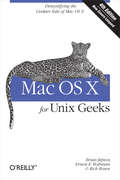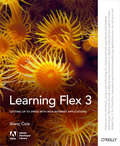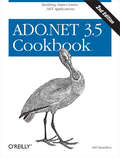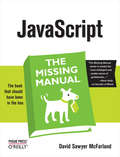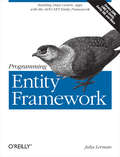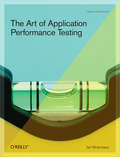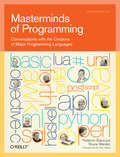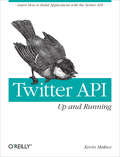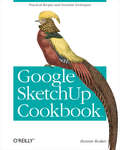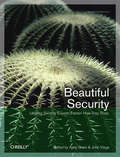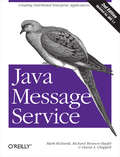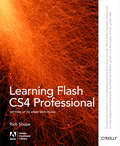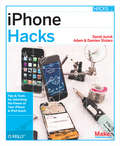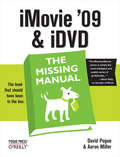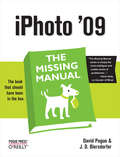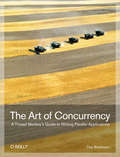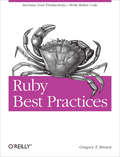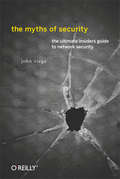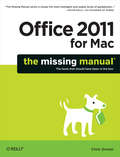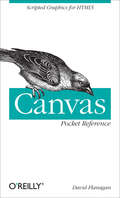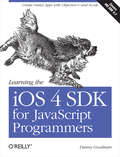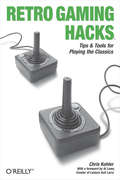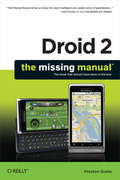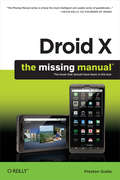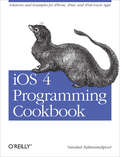- Table View
- List View
Mac OS X for Unix Geeks (Leopard): Demistifying the Geekier Side of Mac OS X
by Brian Jepson Ernest E. Rothman Rich RosenIf you're a developer or system administrator lured to Mac OS X because of its Unix roots, you'll quickly discover that performing Unix tasks on a Mac is different than what you're accustomed to. Mac OS X for Unix Geeks serves as a bridge between Apple's Darwin OS and the more traditional Unix systems. This clear, concise guide gives you a tour of Mac OS X's Unix shell in both Leopard and Tiger, and helps you find the facilities that replace or correspond to standard Unix utilities. You'll learn how to perform common Unix tasks in Mac OS X, such as using Directory Services instead of the standard Unix /etc/passwd and /etc/group, and you'll be able to compile code, link to libraries, and port Unix software using either Leopard and Tiger. This book teaches you to:Navigate the Terminal and understand how it differs from an xterm Use Open Directory (LDAP) and NetInfo as well as Directory Services Compile your code with GCC 4 Port Unix programs to Mac OS X with Fink Use MacPorts to install free/open source software Search through metadata with Spotlight's command-line utilities Build the Darwin kernel And there's much more. Mac OS X for Unix Geeks is the ideal survival guide to tame the Unix side of Leopard and Tiger. If you're a Unix geek with an interest in Mac OS X, you'll soon find that this book is invaluable.
Learning Flex 3: Getting up to Speed with Rich Internet Applications (Adobe Developer Library)
by Alaric ColeHow soon can you learn Adobe Flex 3? With this book's unique hands-on approach, you will be able to tinker with examples right away, and create your own Rich Internet Applications with Flex within the first few chapters. As you progress, you learn how to build a layout, add interactivity, work with data, and deploy your applications to either the Web or the desktop.Learning Flex 3 offers step-by-step instructions that are clear and concise, along with tips and tricks that author Alaric Cole has gathered after years of using Flex and teaching it to fellow developers at Yahoo! You'll understand how Flex works, how to use the MXML markup language and work with ActionScript, how to deploy RIAs to the desktop using Adobe AIR, and much more. Whether you're a beginner, or an experienced web developer coming to Flex from another platform, Learning Flex 3 is the ideal way to learn how to:Set up your environment with FlexBuilder and Eclipse Create a new Flex project Use the different design views in Flex Write code with MXML Lay out your Flex application Embed images and graphics Build a user interface Add interactivity with ActionScript Handle user input Move, display, and collect data Add custom components with MXML Add sound effects, filters, and transitions Style your applications with CSS, skins, and themes Deploy applications to the Web, or to the desktop using Adobe AIR Also included are brief explanations of objects, classes, components, properties, methods, types, and other Flex attributes. You will find that Learning Flex 3 is not only the most complete tutorial for Flex, it's also the quickest way to get going with the latest version of this powerful framework.
ADO.NET 3.5 Cookbook: Building Data-Centric .NET Applications (Cookbooks (O'Reilly))
by Bill HamiltonThis guide is strikingly different from other books on Microsoft ADO.NET. Rather than load you down with theory, the new edition of ADO.NET 3.5 Cookbook gives you more than 200 coding solutions and best practices for real problems you're likely to face with this technology using Visual Studio 2008 and the .NET 3.5 platform. Organized to help you find the topic and specific recipe you need quickly and easily, this book is more than just a handy compilation of cut-and-paste C# code. ADO.NET 3.5 Cookbook also offers clear explanations of how and why each code solution works, and warns you of potential pitfalls so you can learn to adapt the book's problem-solving techniques to different situations. This collection of timesaving recipes covers vital topics including: Connecting to data Retrieving and managing data Transforming and analyzing data Modifying data Binding data to .NET user interfaces Optimizing .NET data access Enumerating and maintaining database objects Maintaining database integrity Ideal for ADO.NET programmers at all levels, from the relatively inexperienced to the most sophisticated, this new edition covers the significant 3.5 upgrade, including new programming tools such as LINQ. ADO.NET 3.5 Cookbook offers a painless way for those of you who prefer to learn by doing when it comes to expanding your skills and productivity.
JavaScript: The Missing Manual (Missing Manual)
by David Sawyer McfarlandJavaScript is an essential language for creating modern, interactive websites, but its complex rules challenge even the most experienced web designers. With JavaScript: The Missing Manual, you'll quickly learn how to use JavaScript in sophisticated ways -- without pain or frustration -- even if you have little or no programming experience. JavaScript expert David McFarland first teaches you the basics by having you build a simple program. Then you'll learn how to work with jQuery, a popular library of pre-built JavaScript components that's free and easy to use. With jQuery, you can quickly build modern, interactive web pages -- without having to script everything from scratch! Learn how to add scripts to a web page, store and manipulate information, communicate with the browser window, respond to events like mouse clicks and form submissions, and identify and modify HTML Get real-world examples of JavaScript in action Learn to build pop-up navigation bars, enhance HTML tables, create an interactive photo gallery, and make web forms more usable Create interesting user interfaces with tabbed panels, accordion panels, and pop-up dialog boxes Learn to avoid the ten most common errors new programmers make, and how to find and fix bugs Use JavaScript with Ajax to communicate with a server so that your web pages can receive information without having to reload
Programming Entity Framework: Code First
by Julia LermanIf you use Entity Framework in Visual Studio 2008 and .NET 3.5, this is the book you want. Programming Entity Framework, 1st Edition offers experienced developers a thorough introduction to Microsoft's core framework for modeling and interacting with data in .NET applications. This hands-on tour provides a deep understanding of Entity Framework's architecture and APIs, and explains how to use the framework in a variety of applications built with Visual Studio 2008 and .NET 3.5.From the Entity Data Model (EDM) and Object Services to EntityClient and the Metadata Workspace, this highly acclaimed first edition covers it all.Understand the core concepts you need to make the best use of the Entity Framework (EF) in your applicationsLearn to query your data, using either LINQ to Entities or Entity SQLCreate Windows Forms, WPF, and ASP.NET applicationsBuild ASMX web services and WCF servicesUse Object Services to work directly with your entity objectsDelve into model customization, relationship management, change tracking, data concurrency, and moreOne important note: while many of the lessons from this book will continue to be valuable as you move to .NET 4, the thoroughly revised second edition of Programming Entity Framework (August 2010) specifically targets Visual Studio 2010 and .NET 4 -- where there have been many advancements and additions to the framework.
The Art of Application Performance Testing: Help for Programmers and Quality Assurance
by Ian MolyneauxThis practical book provides a step-by-step approach to testing mission-critical applications for scalability and performance before they're deployed -- a vital topic to which other books devote one chapter, if that.Businesses today live and die by network applications and web services. Because of the increasing complexity of these programs, and the pressure to deploy them quickly, many professionals don't take the time to ensure that they'll perform well and scale effectively. The Art of Application Performance Testing explains the complete life cycle of the testing process, and demonstrates best practices to help you plan, gain approval for, coordinate, and conduct performance tests on your applications. With this book, you'll learn to:Set realistic performance testing goalsImplement an effective application performance testing strategyInterpret performance test resultsCope with different application technologies and architecturesUse automated performance testing toolsTest traditional local applications, web-based applications, and web services (SOAs)Recognize and resolves issues that are often overlooked in performance testsWritten by a consultant with 30 years of experience in the IT industry and over 12 years experience with performance testing, this easy-to-read book is illustrated with real-world examples and packed with practical advice. The Art of Application Performance Testing thoroughly explains the pitfalls of an inadequate testing strategy and offers you a robust, structured approach for ensuring that your applications perform well and scale effectively when the need arises."Ian has maintained a vendor-agnostic methodology beautifully in this material. The metrics and graphs, along with background information provided in his case studies, eloquently convey to the reader, 'Methodology above all, tools at your discretion...' Ian's expertise shines through throughout the entire reading experience."-- Matt St. Onge, Enterprise Solution Architect, HCL Technologies America / Teradyne
Masterminds of Programming: Conversations with the Creators of Major Programming Languages (Theory in Practice (O'Reilly))
by Chromatic Federico BiancuzziMasterminds of Programming features exclusive interviews with the creators of several historic and highly influential programming languages. In this unique collection, you'll learn about the processes that led to specific design decisions, including the goals they had in mind, the trade-offs they had to make, and how their experiences have left an impact on programming today. Masterminds of Programming includes individual interviews with: Adin D. Falkoff: APL Thomas E. Kurtz: BASIC Charles H. Moore: FORTH Robin Milner: ML Donald D. Chamberlin: SQL Alfred Aho, Peter Weinberger, and Brian Kernighan: AWK Charles Geschke and John Warnock: PostScript Bjarne Stroustrup: C++ Bertrand Meyer: Eiffel Brad Cox and Tom Love: Objective-C Larry Wall: Perl Simon Peyton Jones, Paul Hudak, Philip Wadler, and John Hughes: Haskell Guido van Rossum: Python Luiz Henrique de Figueiredo and Roberto Ierusalimschy: Lua James Gosling: Java Grady Booch, Ivar Jacobson, and James Rumbaugh: UML Anders Hejlsberg: Delphi inventor and lead developer of C# If you're interested in the people whose vision and hard work helped shape the computer industry, you'll find Masterminds of Programming fascinating.
Twitter API: Learn How to Build Applications with the Twitter API
by Kevin MakiceThis groundbreaking book provides you with the skills and resources necessary to build web applications for Twitter. Perfect for new and casual programmers intrigued by the world of microblogging, Twitter API: Up and Running carefully explains how each part of Twitter's API works, with detailed examples that show you how to assemble those building blocks into practical and fun web applications. You'll also get a complete look at Twitter culture and learn how it has inspired programmers to build hundreds of tools and applications. With this book, you will: Explore every component of a Twitter application and learn how the API responds Get the PHP and MySQL code necessary to build your own applications, with explanations of how these ingredients work Learn from real-world Twitter applications created just for this book Discover the most interesting and useful Twitter programs--and get ideas for creating your own--with the book's Twitter application directoryTwitter offers a new way to connect with people on the Internet, and Twitter API: Up and Running takes you right to the heart of this technology. "Twitter API: Up and Running is a friendly, accessible introduction to the Twitter API. Even beginning web developers can have a working Twitter project before they know it. Sit down with this for a weekend and you're on your way to Twitter API mastery." --Alex Payne, Twitter API Lead "Twitter API: Up and Running is a very comprehensive and useful resource--any developer will feel the urge to code a Twitter-related application right after finishing the book!" --The Lollicode team, creators of Twitscoop
Google SketchUp Cookbook: Practical Recipes and Essential Techniques
by Bonnie RoskesAs the first book for intermediate and advanced users of Google SketchUp, this Cookbook goes beyond the basics to explore the complex features and tools that design professionals use. You'll get numerous step-by-step tutorials for solving common (and not so common) design problems, with detailed color graphics to guide your way, and discussions that explain additional ways to complete a task. Google SketchUp Cookbook will help you: Use SketchUp more efficiently by taking advantage of components and groups Learn new techniques for using Follow Me, Intersect, and constraints Go beyond simple textures with tools such as texture positioning and Photo Match Create animations and walkthroughs, and explore design scenarios by using layers and scenes Learn how to use styles to customize your presentations Combine SketchUp with the 3D Warehouse and Google Earth Google SketchUp Cookbook is ideal for architects, engineers, interior designers, product designers, woodworkers, and other professionals and hobbyists who want to work more efficiently and achieve true mastery of this amazing tool.
Beautiful Security: Leading Security Experts Explain How They Think
by John Viega Andy OramAlthough most people don't give security much attention until their personal or business systems are attacked, this thought-provoking anthology demonstrates that digital security is not only worth thinking about, it's also a fascinating topic. Criminals succeed by exercising enormous creativity, and those defending against them must do the same. Beautiful Security explores this challenging subject with insightful essays and analysis on topics that include: The underground economy for personal information: how it works, the relationships among criminals, and some of the new ways they pounce on their prey How social networking, cloud computing, and other popular trends help or hurt our online security How metrics, requirements gathering, design, and law can take security to a higher level The real, little-publicized history of PGP This book includes contributions from: Peiter "Mudge" Zatko Jim Stickley Elizabeth Nichols Chenxi Wang Ed Bellis Ben Edelman Phil Zimmermann and Jon Callas Kathy Wang Mark Curphey John McManus James Routh Randy V. Sabett Anton Chuvakin Grant Geyer and Brian Dunphy Peter Wayner Michael Wood and Fernando Francisco All royalties will be donated to the Internet Engineering Task Force (IETF).
Java Message Service: Creating Distributed Enterprise Applications
by Richard Monson-Haefel David A Chappell Mark RichardsJava Message Service, Second Edition, is a thorough introduction to the standard API that supports "messaging" -- the software-to-software exchange of crucial data among network computers. You'll learn how JMS can help you solve many architectural challenges, such as integrating dissimilar systems and applications, increasing scalability, eliminating system bottlenecks, supporting concurrent processing, and promoting flexibility and agility. Updated for JMS 1.1, this second edition also explains how this vendor-agnostic specification will help you write messaging-based applications using IBM's MQ, Progress Software's SonicMQ, ActiveMQ, and many other proprietary messaging services. With Java Message Service, you will: Build applications using point-to-point and publish-and-subscribe messaging models Use features such as transactions and durable subscriptions to make an application reliable Implement messaging within Enterprise JavaBeans (EJB) using message-driven beans Use JMS with RESTful applications and with the Spring application framework Messaging is a powerful paradigm that makes it easier to uncouple different parts of an enterprise application. Java Message Service, Second Edition, will quickly teach you how to use the key technology that lies behind it.
Learning Flash CS4 Professional: Getting Up to Speed with Flash (Adobe Developer Library)
by Rich ShupeLearning Flash CS4 Professional offers beginners and intermediate Flash developers a unique introduction to the latest version of Adobe's powerful multimedia application. This easy-to-read book is loaded with full-color examples and hands-on tasks to help you master Flash CS4's new motion editor, integrated 3D system, and character control with the new inverse kinematics animation system. No previous Flash experience is necessary. This book will help you: Understand Flash fundamentals with clear, concise information you can use right away Learn key concepts and techniques in every chapter, with annotated screenshots and illustrations Develop an ongoing project that utilizes material from every chapter Practice new skills and test your understanding with constructive exercises Learn how to package your work for distribution on the Web and through AIR desktop applications Download sample files and discuss additional Flash features on the companion blog As part of the Adobe Developer Library, this is the most authoritative guide to Flash CS4 available. Get moving with Flash today!
iPhone Hacks: Pushing the iPhone and iPod touch Beyond Their Limits (Hacks)
by Damien Stolarz Adam Stolarz David JurickWith iPhone Hacks, you can make your iPhone do all you'd expect of a mobile smartphone -- and more. Learn tips and techniques to unleash little-known features, find and create innovative applications for both the iPhone and iPod touch, and unshackle these devices to run everything from network utilities to video game emulators. This book will teach you how to: Import your entire movie collection, sync with multiple computers, and save YouTube videos Remotely access your home network, audio, and video, and even control your desktop Develop native applications for the iPhone and iPod touch on Linux, Windows, or Mac Check email, receive MMS messages, use IRC, and record full-motion video Run any application in the iPhone's background, and mirror its display on a TV Make your iPhone emulate old-school video game platforms, and play classic console and arcade games Integrate your iPhone with your car stereo Build your own electronic bridges to connect keyboards, serial devices, and more to your iPhone without "jailbreaking" iPhone Hacks explains how to set up your iPhone the way you want it, and helps you give it capabilities that will rival your desktop computer. This cunning little handbook is exactly what you need to make the most of your iPhone.
iMovie '09 & iDVD: The Missing Manual (Missing Manual)
by David Pogue Aaron MillerBursting with new features, Apple's iMovie '09 is vastly more usable and complete than iMovie '08 -- amazing right out of the box. But the box doesn't include a good user's guide, so learning these applications is another matter. iMovie '09 and iDVD: The Missing Manual gets you up to speed on everything you need to turn raw digital footage into highly creative video projects.You get crystal-clear, jargon-free explanations of iMovie's new video effects, slow & fast motion, advanced drag & drop, video stabilization, and more. Author and New York Times tech columnist David Pogue uses an objective lens to scrutinize every step of process, including how to:Organize your videos just like your photos, and precisely edit with easeWork on multiple iMovie projects at once and drag & drop clips among themIntegrate with other iLife programs to use songs, photos, and an original sound trackOutput your creation to a blog, its own web page, or as a video podcast with iWebUnderstand basic film techniques to improve the quality of the video you bring to iMovieFrom choosing and using a digital camcorder to burning the finished work onto DVDs, posting it online, or creating versions for iPod and iPhone, iMovie '09 & iDVD: The Missing Manual helps you zoom right in on the details.
iPhoto '09: The Missing Manual (Missing Manual)
by David Pogue J. D. BiersdorferWith iPhoto '09, Apple's popular photo organizer and editing program is better than ever. Unfortunately, intuitive as it may be, iPhoto still has the power to confuse anyone who uses it. That's why more people rely on our Missing Manual than any other iPhoto resource. Author and New York Times tech columnist David Pogue provides clear and objective guidance on every iPhoto feature, including new tools such as face recognition, place recognition based on GPS data, themed slideshows, online sharing, enhanced editing, and travel maps. You'll find step-by-step instructions, along with many undocumented tips and tricks. With iPhoto '09: The Missing Manual, you will: Get a course in picture-taking and digital cameras -- how to buy and use a digital camera, how to compose brilliant photos in various situations Import, organize, and file your photos -- and learn how to search and edit them Create slideshows, photo books, calendars, and greeting cards, and either make or order prints Share photos on websites or by email, and turn photos into screensavers or desktop pictures Learn to manage your Photo Libraries, use plug-ins, and get photos to and from camera phones There's much more in this comprehensive guide. Discover today why iPhoto '09: The Missing Manual is the top-selling iPhoto book.
The Art of Concurrency: A Thread Monkey's Guide to Writing Parallel Applications
by Clay BreshearsIf you're looking to take full advantage of multi-core processors with concurrent programming, this practical book provides the knowledge and hands-on experience you need. The Art of Concurrency is one of the few resources to focus on implementing algorithms in the shared-memory model of multi-core processors, rather than just theoretical models or distributed-memory architectures. The book provides detailed explanations and usable samples to help you transform algorithms from serial to parallel code, along with advice and analysis for avoiding mistakes that programmers typically make when first attempting these computations. Written by an Intel engineer with over two decades of parallel and concurrent programming experience, this book will help you: Understand parallelism and concurrency Explore differences between programming for shared-memory and distributed-memory Learn guidelines for designing multithreaded applications, including testing and tuning Discover how to make best use of different threading libraries, including Windows threads, POSIX threads, OpenMP, and Intel Threading Building Blocks Explore how to implement concurrent algorithms that involve sorting, searching, graphs, and other practical computations The Art of Concurrency shows you how to keep algorithms scalable to take advantage of new processors with even more cores. For developing parallel code algorithms for concurrent programming, this book is a must.
Ruby Best Practices: Increase Your Productivity - Write Better Code
by Gregory T BrownHow do you write truly elegant code with Ruby? Ruby Best Practices is for programmers who want to use Ruby as experienced Rubyists do. Written by the developer of the Ruby project Prawn, this concise book explains how to design beautiful APIs and domain-specific languages with Ruby, as well as how to work with functional programming ideas and techniques that can simplify your code and make you more productive. You'll learn how to write code that's readable, expressive, and much more. Ruby Best Practices will help you: Understand the secret powers unlocked by Ruby's code blocks Learn how to bend Ruby code without breaking it, such as mixing in modules on the fly Discover the ins and outs of testing and debugging, and how to design for testability Learn to write faster code by keeping things simple Develop strategies for text processing and file management, including regular expressions Understand how and why things can go wrong Reduce cultural barriers by leveraging Ruby's multilingual capabilities This book also offers you comprehensive chapters on driving code through tests, designing APIs, and project maintenance. Learn how to make the most of this rich, beautiful language with Ruby Best Practices.
The Myths of Security: What the Computer Security Industry Doesn't Want You to Know
by John ViegaIf you think computer security has improved in recent years, The Myths of Security will shake you out of your complacency. Longtime security professional John Viega, formerly Chief Security Architect at McAfee, reports on the sorry state of the industry, and offers concrete suggestions for professionals and individuals confronting the issue. Why is security so bad? With many more people online than just a few years ago, there are more attackers -- and they're truly motivated. Attacks are sophisticated, subtle, and harder to detect than ever. But, as Viega notes, few people take the time to understand the situation and protect themselves accordingly. This book tells you: Why it's easier for bad guys to "own" your computer than you think Why anti-virus software doesn't work well -- and one simple way to fix it Whether Apple OS X is more secure than Windows What Windows needs to do better How to make strong authentication pervasive Why patch management is so bad Whether there's anything you can do about identity theft Five easy steps for fixing application security, and more Provocative, insightful, and always controversial, The Myths of Security not only addresses IT professionals who deal with security issues, but also speaks to Mac and PC users who spend time online.
Office 2011 for Macintosh: The Missing Manual
by Chris GroverOffice 2011 for Mac is easy to use, but to unleash its full power, you need to go beyond the basics. This entertaining guide not only gets you started with Word, Excel, PowerPoint, and the new Outlook for Mac, it also reveals useful lots of things you didn't know the software could do. Get crystal-clear explanations on the features you use most -- and plenty of power-user tips when you're ready for more. Take advantage of new tools. Navigate with the Ribbon, use SmartArt graphics, and work online with Office Web Apps. Create professional-looking documents. Use Word to craft beautiful reports, newsletters, brochures, and posters. Crunch numbers with ease. Assemble data, make calculations, and summarize the results with Excel. Stay organized. Set up Outlook to track your email, contacts, appointments, and tasks. Make eye-catching presentations. Build PowerPoint slideshows with video and audio clips, animations, and other features. Use the programs together. Discover how to be more productive and creative by drawing directly in Word documents, adding spreadsheets to your slides, and more.
Canvas Pocket Reference: Scripted Graphics for HTML5
by David FlanaganThe Canvas element is a revolutionary feature of HTML5 that enables powerful graphics for rich Internet applications, and this pocket reference provides the essentials you need to put this element to work. If you have working knowledge of JavaScript, this book will help you create detailed, interactive, and animated graphics -- from charts to animations to video games -- whether you're a web designer or a programmer interested in graphics. Canvas Pocket Reference provides both a tutorial that covers all of the element's features with plenty of examples and a definitive reference to each of the Canvas-related classes, methods, and properties. You'll learn how to: Draw lines, polygons, and curves Apply colors, gradients, patterns, and transparency Use transformations to smoothly rotate and resize drawings Work with text in a graphic environment Apply shadows to create a sense of depth Incorporate bitmapped images into vector graphics Perform image processing operations in JavaScript
Learning the iOS 4 SDK for JavaScript Programmers: Create Native Apps with Objective-C and Xcode
by Danny GoodmanIs it possible for JavaScript programmers to learn Apple's iOS 4 SDK and live to tell the tale? Technology guru Danny Goodman did, and with this book he leaves a well-marked trail for you to follow. An authority on JavaScript since its inception, Goodman understands the challenges you might face in creating native iOS apps with this SDK, and introduces Xcode, Objective-C, and Cocoa Touch in a context you'll readily understand. Why bother with the SDK when you can simply build web apps for Apple's iOS devices? Web apps can't access an iPhone's music library, camera, or iOS system software for maps, audio, and more. Nor can you sell web apps in the App Store. If you want to take full advantage of the iPhone and iPad, iOS 4 SDK is your tool -- and this is your book. Includes full coverage of iOS SDK 4.2. Learn the distinction between web app and iOS native app programming Create a workbench app to test code snippets throughout the learning process Get a structural view of an iOS app, and compare the process of building objects in Objective-C versus JavaScipt Discover how your code launches iOS apps and makes them user-ready Learn about iOS memory management details that are different from JavaScript, including pointers and data types Use Objective-C and Cocoa Touch to implement common JavaScript tasks
Retro Gaming Hacks: Tips & Tools for Playing the Classics
by Chris KohlerMaybe it was the recent Atari 2600 milestone anniversary that fueled nostalgia for the golden days of computer and console gaming. Every Game Boy must ponder his roots from time to time. But whatever is driving the current retro gaming craze, one thing is certain: classic games are back for a big second act, and they're being played in both old and new ways. Whether you've just been attacked by Space Invaders for the first time or you've been a Pong junkie since puberty, Chris Kohler's Retro Gaming Hacks is the indispensable new guide to playing and hacking classic games. Kohler has complied tons of how-to information on retro gaming that used to take days or weeks of web surfing to track down and sort through, and he presents it in the popular and highly readable Hacks style. Retro Gaming Hacks serves up 85 hard-nosed hacks for reviving the classic games. Want to game on an original system? Kohler shows you how to hack ancient hardware, and includes a primer for home-brewing classic software. Rather adapt today's equipment to run retro games? Kohler provides emulation techniques, complete with instructions for hacking a classic joystick that's compatible with a contemporary computer. This book also teaches readers to revive old machines for the original gaming experience: hook up an Apple II or a Commodore 64, for example, and play it like you played before. A video game journalist and author of Power Up: How Japanese Video Games Gave the World an Extra Life, Kohler has taught the history of video games at Tufts University. In Retro Gaming Hacks, he locates the convergence of classic games and contemporary software, revealing not only how to retrofit classic games for today's systems, but how to find the golden oldies hidden in contemporary programs as well. Whether you're looking to recreate the magic of a Robotron marathon or simply crave a little handheld Donkey Kong, Retro Gaming Hacks shows you how to set the way-back dial.
Droid 2: The Missing Manual
by Preston GrallaReady to unleash the Droid 2? This entertaining guide helps you take full command of Motorola’s sleek new device to get online, shop, find locations, keep in touch, and much more. Every page is packed with useful information you can put to work right away, from setup to troubleshooting, with lots of valuable tips and tricks along the way.Get organized. Sync your contacts, calendar, and email with your Google Calendar and Outlook accounts.Go online. Make your phone a portable hotspot or a modem to get your laptop online.Be productive. Use Google docs to create and edit documents, spreadsheets, and presentations.Play music. Purchase music from Amazon and sync your Droid 2 with Windows Media Player.Capture photos and video. Edit your photos and share everything you shoot—instantly.
Droid X: The Missing Manual
by Preston GrallaGet the most from your Droid X right away with this entertaining Missing Manual. Veteran tech author Preston Gralla offers a guided tour of every feature, with lots of expert tips and tricks along the way. You'll learn how to use calling and texting features, take and share photos, enjoy streaming music and video, and much more.Packed with full-color illustrations, this engaging book covers everything from getting started to advanced features and troubleshooting. Unleash the power of Motorola's hot new device with Droid X: The Missing Manual.Get organized. Import your contacts and sync with Google Calendar and Microsoft Exchange.Go online. Get your phone to act as a portable hotspot or as a modem to get your laptop online.Play music. Purchase music from Amazon and sync your Droid X with Windows Media Player and iTunes.Shoot photos and video. Edit and share your photos, and use them as desktop or icon images. Record video and share it with your friends.Connect to Google Maps. Use geotagging and get turn-by-turn directions.
iOS 4 Programming Cookbook: Solutions & Examples for iPhone, iPad, and iPod touch Apps
by Vandad NahavandipoorYou can build a variety of amazing apps on the iOS platform—and every one of them presents a unique set of problems. With the recipes in this cookbook, you'll go beyond theory to solve the vexing, real-life issues you’re likely to face when creating apps for the iPhone, iPad, or iPod Touch. Each recipe provides a clear solution and sample code that you can use right away.You'll find solutions for working with development frameworks in iOS SDK 4 and technologies such as Cocoa, Objective-C, Xcode, and Interface Builder. Whether you have a little or a lot of experience with iOS development, you’ll find the help you need for every phase of the process, from initial idea to completed project.Work with Objective-C classes, objects, properties, delegates, and memory managementConstruct a user interface with gesture recognizersDevelop location-aware applications with the Map Kit and Core Location APIsBuild apps that play audio and video, manage calendars and events, access contacts and groups, or tap into the Photo LibraryUse the Core Motion framework to access the accelerometer and gyroscopeMaintain persistent storage for iOS apps with the Core Data frameworkCreate multitasking-aware apps that let users leave and return without losing their place
